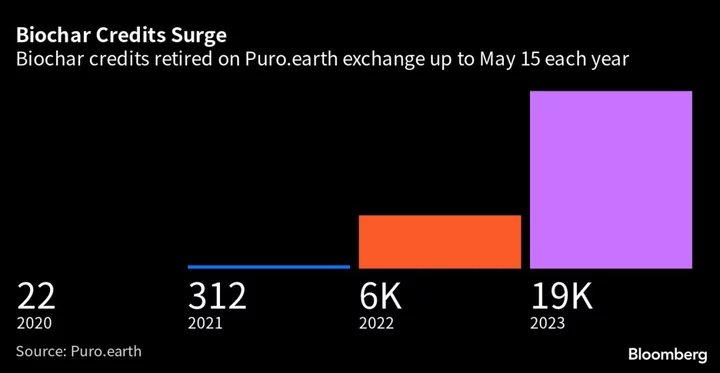A type of charcoal first used by Amazonian tribes thousands of years ago is becoming a key component of net-zero goals set by Microsoft Corp., JPMorgan Chase & Co. and other blue chip companies eager to offset their carbon emissions.
Known as biochar, this black substance created by heating biomass and other agricultural waste can store carbon for hundreds of years and improve soil quality at the same time. It’s a “true carbon removal solution at scale,” according to Microsoft, and the tech giant along with BlackRock Inc. and JPMorgan are among those that have bought biochar credits.
The market for biochar remains small for now, thought it seems poised to soar as more farmers use it as a soil additive and companies seek new ways to meet net-zero targets. Biochar has the potential to sequester up to 2 billion tons of carbon dioxide annually by 2050, or almost as much as India emits in a year.
Biochar’s popularity stems from a shift in the voluntary carbon markets toward projects that actually remove carbon, instead of the so-called avoidance offsets that keep existing trees standing, for example. Some firms are warming to the idea that you “put a ton in, you take a ton out,” said Rich Gilmore, chief executive officer of investment manager Carbon Growth Partners.
Among removals, biochar offsets are sought for their “co-benefits to the ecosystem, biodiversity and soil,” said Melissa Leung, director of carbon at biochar consultancy GECA Environnement in Quebec City.
Biochar is produced by heating wood and other biomass in a low-oxygen chamber that limits emissions, in a process known as pyrolysis. As the biomass heats, bio-oils and gas are also produced, which can be used for power generation. Biochar can be buried in the ground as a soil amendment, or integrated into building materials, among other uses. For every ton of biochar produced, roughly three tons of carbon dioxide are sequestered.
Biochar credits sell for about €111 ($120) each, according to a tracker by Puro.earth, a Helsinki-based carbon registry that was bought by Nasdaq Inc. in 2021. That’s a hundred times more than nature-based offsets, but still only a fraction of the current price of other kinds of removal offsets such as electrochemical ocean carbon capture.
Even after prices jumped 29% last year, biochar credit retirements more than doubled on Puro.earth, signaling strong demand. Puro.earth CEO Antti Vihavainen expects the market value to double this year as interest soars from US companies, which make up half the platform’s buyers.
JPMorgan, which has been buying biochar credits since 2021, deems it an attractive option because of its “longer-term durability, relative affordability and co-benefits,” Brian DiMarino, head of operational sustainability, said by email.
Biochar’s origins date back centuries when ancient Amerindians in the Amazon used charcoal, broken ceramics, compost and other household waste to make Terra Preta de Indio, or Amazonian Dark Earth. Either by accident or design, these societies created a porous topsoil that retains water and hosts nutrients. Settlers in the 19th and 20th centuries gravitated to Dark Earth sites because land in the rest of the Amazon is acidic and not suited for agriculture.
Rainbow Bee Eater is one of Puro.earth’s biggest suppliers of biochar credits in Australia. Peter Burgess, who co-founded the company in 2007, says the goal was always to take biomass that would otherwise be thrown away and turn it into biochar.
The company struggled for years as part of a backyard industry with low volume and a negligible climate impact. Farmers, used to boom and bust weather cycles, were reluctant to adopt new techniques and averse to extra costs, given that a truck load of biochar can cost up to 10 times more than regular soil amendments.
But in 2018, the Intergovernmental Panel on Climate Change recognized biochar as a source of carbon sequestration. Because biochar decomposes far more slowly than biomass, the locked-up carbon won’t re-enter the atmosphere for hundreds of years, making it a viable method of carbon capture.
Biochar offsets “changed everything,” Burgess said. The additional income allowed him to drop the price of biochar by 60% to 80%, encouraging more farmers to try it. Rainbow Bee Eater now has two pyrolysis plants, and the plan is to “build more projects, hire more people, make more money and build even more projects,” Burgess said.
Other countries are getting on board. The US Department of Agriculture has funding available for farmers who apply biochar and meet certain conditions. Production surged fivefold from 2015 through 2021, when it reached about 800,000 tons, with the fastest growth in China, according to Verra, the largest carbon offsets verifier. By value, the market may almost triple to about $633 million by 2032, according to Precedence Research.
The challenges for biochar include gaining scale and boosting reliability. Biochar remains a “very small niche” in a more than $1 billion offsets market, Vihavainen said.
As biochar grows in popularity, experts worry the industry will attract developers that aren’t following biochar production and offset standards. Australia-based Pyrocal Pty, which sells biochar systems, says inquiries for its technology have grown fivefold since the boom in offsets two years ago. Yet many operators aren’t managing their emissions to global standards, according to Managing Director Durell Hammond.
Still, the credits sit at an “interesting intersection between technology and nature,” said Frederick Teo, CEO at Temasek Holdings Pte-backed GenZero, which has S$5 billion ($3.7 billion) to spend on climate projects.
“We are very constructive on biochar,” he said in Singapore. “It has promise. It is scalable.”
Author: Sheryl Tian Tong Lee, Peter Millard and Heesu Lee

